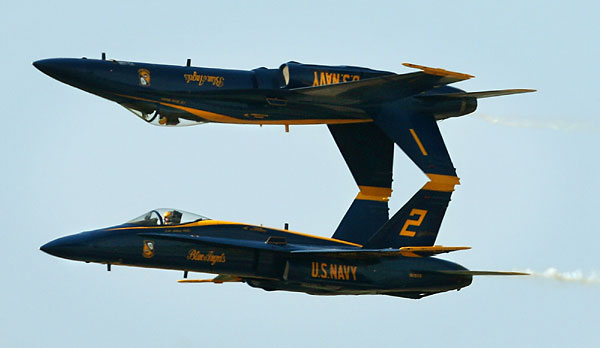The most dramatic example of agreement and traveling together I have seen is formation flying. In formation flying,one aircraft (and pilot) is designated as the lead. The leader is responsible for all the navigating and managing where the flight will go. The other pilots’ job is to stay in formation. To do that, the wingmen maneuver their aircraft to maintain a position with the wing-tip separation of three feet (yes that’s 3’!). For those who are used to the metric system, that is “Less-than-a-meter-o-my-gosh-doesn’t-that-plane-look-huge-that-close!” To give you an idea of how close it is, one can easily see the + in the top of the Phillips-head screws on the plane. You can see the eraser on the pencil in the sleeve pocket of the lead pilot. You can see the plane and it is CLOSE.
There are lots of problems with formation flying, but most people are surprised by things that are not a problem. For example, most people think that the fact that the formation flying at 500 mph is a big deal. Speed is not an issue because all the planes in the formation are flying at that speed. All you see is the relative speed difference between your plan and the others.
Another issue is breathing. That has two possible problems. The first is not breathing at all. Holding one’s breath in anxiety is not helpful. Neither is hyperventilating.
New formation pilots usually develop what is called PIO. That stands for Pilot Induced Oscillation. It means that as a correction is applied to the flight controls, the inexperienced pilot will over control the aircraft. When they try to come back the other way, control has to be applied in the other direction. If (likely!) excess control is put in in that direction, the aircraft will overshoot its intended place. If the pilot jerks the plane back in the right direction, but it is over controlled, now it needs another correction back. As the process continues, the plane bucks like a porpoise jumping up and down. Once PIO gets started, it is really hard to stop.
In a four ship formation, the worst position to have to fly is position three. Lead has some challenges, but the lead pilot does not have to follow other planes. He/she just flies deliberately trying to keep in mind that there are three more planes behind. The lead pilot has to do all the navigating. All the others do is fly formation. Trust levels have to be extremely high. I have written before about a time flying formation in the weather that I was convinced we were inverted and almost supersonic in speed. When the lead pilot signaled to lower the gear on his head nod, I thought he was crazy. If I was right about our speed, lowering the gear would result in catastrophic failure as the wheels would be ripped off the plane. In fact, we were in weather but very close to landing for which having the landing gear down is very helpful!
Flying in position two is not too challenging, because you are just following the leader. The pilot in position four can back off and fly a looser formation allowing the other three planes to flail around the sky. It may not be elegant to be number four, but it is safe. Number three, however, has to fly formation off of number two who is usually gyrating all over the place trying to stay tucked in to lead. Three can’t back off because four is out there in the way. Three is at the mercy of number two. My strategy is to make the best pilot the number two guy. That makes life a lot easier for the rest of the flight, as long as lead doesn’t fly into a mountain. That would result not in one crash, but if they stayed in a tight formation, all four would crash. In a close formation, the other pilots are not watching anything but the other planes in the flight.
A lot of people are looking at the situation in the Anglican Communion and decrying the lack of leadership in the structures of the Anglican Communion. In fact, there is not a lack of leadership at all. Tragically, there is a great deal of bad leadership. The Instruments of the Communion have not all failed, but the contamination of Western influence and money has had a terrible impact.

When the Primates met, a great deal of energy went into trying to manage their agenda so they didn’t talk about the problems in the Communion. When they did manage to muscle through a conversation and agree to what was needed to fix the problems, Archbishop Williams simply refused to follow through on what they decided. In fact, the only things he ever did follow through on were things that would advance the heretical agenda of the liberals.
When the rules and the structures were such that the Gospel was not only not being served but it was being undermined and even opposed, those Anglicans who remained faithful to Biblical faith did what the number four plane would do in a formation. They have not left the Air Force, they have just backed off from where “lead” is taking them. The way that has surfaced is not that they have broken with the structures, but many of the orthodox leaders have backed away and are no longer committed to simply trusting “lead.”
When the new Archbishop of Canterbury came into office, there was a question as to whether international leadership would re-set everything back to a baseline, showing up at everything and giving the new Primus the opportunity to set his agenda. Instead, many of them felt that the structures had become so compromised that while they wanted to give Archbishop Welby a chance, they insisted that steps be demonstrated to restore orthodoxy. In the mean time, the Pilling Report has come out that gives every indication of advancing the liberal agenda through the death of ten thousand indaba water torture crazy making conversations. Of course, no indaba conversation is ever structured to allow a conservative outcome, it is only designed to look like there is real dialogue. The real purpose is to morph the Communion into an organization that incorporates not only same-sex relations, but also one that fuzzes the rough demanding truth that Jesus is the only Way.
As you watch the current Anglican formation flying, it is important to remember two things. The first is that there are other flights going on. The Instruments of Communion flights are not the only flights that are happening. Biblically faithful Anglicans are not limiting their activities to institutional gatherings. They are doing other things that are identifiably Biblical. The second thing is if you watch closely, you can see that when Anglicans are in situations where they are flying together with other Anglicans who don’t share a commitment to Biblical faith, it is a very loose formation. So loose, in fact, as the revisionist flight insists on impacting the mountain, the faithful pilots who see the context of the flight don’t have to crash. They see and know the danger and are not falling prey to it.
Formation purists will decry the sloppy formation that results. Wizened Anglican pilots of Biblical faith will just smile and nod. They know that in the end, the agenda that departs from Biblical revelation will not survive. In fact, it will result in destruction. Some of us remain committed to the Biblical faith that is The Way. Institutionalists may be irritated at the way we fly, but I don’t think God is.
The Rt. Rev. Bill Atwood is Bishop of the Anglican Church in North America’s International Diocese and was formerly a U.S. Air Force pilot.



